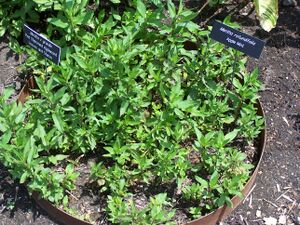Mentha
| Mentha subsp. var. | Mint | |||||||||||||||||||||||||||||||||||||||||||||||||||||||
|---|---|---|---|---|---|---|---|---|---|---|---|---|---|---|---|---|---|---|---|---|---|---|---|---|---|---|---|---|---|---|---|---|---|---|---|---|---|---|---|---|---|---|---|---|---|---|---|---|---|---|---|---|---|---|---|---|

|
|
| ||||||||||||||||||||||||||||||||||||||||||||||||||||||
| ||||||||||||||||||||||||||||||||||||||||||||||||||||||||
Mentha (mint) is a genus of about 25 species (and many hundreds of varieties[1]) of flowering plants in the family Lamiaceae (Mint Family). Species within Mentha have a wide distribution around the world due to its usefulness. Several mint hybrids commonly occur.
Mints are aromatic, almost all perennial, rarely annual, herbs. They have wide-spreading underground rhizomes (roots) and erect, branched stems. The leaves are arranged in opposite pairs, from simple oblong to lanceolate, often downy, and with a serrated margin. Leaf colors range from dark green and gray-green to purple, blue and sometimes pale yellow.[2] The flowers are produced in clusters ('verticils') on an erect spike, white to purple, the corolla two-lipped with four subequal lobes, the upper lobe usually the largest. The fruit is a small dry capsule containing one to four seeds.
While the species that make up the Mentha genus are widely distributed and can be found in many environments, many grow best in wet environments and moist soils. Mints will grow 10–120 cm tall and can spread over an indeterminate sized area. Due to the tendency to spread unchecked, mints are considered invasive.[3]
Species
This covers a selection of what are considered to be pure species of mints. As with all classifications of plants, this list can go out of date at a moment's notice. Listed here are accepted species names and common names (where available). Synonyms, along with cultivars and varieties (where available), are listed under the species.
|
|
Selected hybrids
The mint family has many recognized hybrids. Synonyms, along with cultivars and varieties where available, are included within the specific species.
|
Cultivation

All mints prefer, and thrive, in cool, moist spots in partial shade.[4] In general, mints tolerate a wide range of conditions, and can also be grown in full sun.
They are fast growing, extending their reach along surfaces through a network of runners. Due to their speedy growth, one plant of each desired mint, along with a little care, will provide more than enough mint for home use. Some mint species are more invasive than others. Even with the less invasive mints, care should be taken when mixing any mint with any other plants, lest the mint take over. To control mints in an open environment, mints should be planted in deep, bottomless containers sunk in the ground, or planted above ground in tubs and barrels.[4]
The most common and popular mints for cultivation are peppermint (Mentha × piperita), spearmint (Mentha spicata), and (more recently) apple mint (Mentha suaveolens).
Mints are supposed to make good companion plants, repelling pest insects and attracting beneficial ones.
Propagation
Some mints can be propagated by seed. Growth from seed can be an unreliable method for raising mint for two reasons: mint seeds are highly variable, one might not end up with what one presupposed was planted[4]; some mint varieties are sterile. It is more effective to take and plant cuttings from the runners of healthy mints.
Pests and diseases
- Main article: List of mint diseases
Uses
Herb for cooking, flavoring, medicine, cosmetics, mint oil, teas, salads.
Harvesting of mint leaves can be done at anytime. Fresh mint leaves should be used immediately or stored up to a couple of days in plastic bags within a refrigerator. Optionally, mint can be frozen in ice cube trays. Dried mint leaves should be stored in an airtight container placed in a cool, dark, dry area.[5]
References
- w:Mentha. Some of the material on this page may be from Wikipedia, under the Creative Commons license.
- Mentha QR Code (Size 50, 100, 200, 500)
External links
- ↑ Davidson, Alan (1999). The Oxford Companion to Food. Oxford: Oxford University Press. pp. 508. ISBN 0-19-211579-0.
- ↑ Cite error: Invalid
<ref>tag; no text was provided for refs namedazEncycloPlants - ↑ Brickell, Christopher; Trevor Cole (2002). The American Horticultural Society: Encyclopedia of Plants & Flowers. New York, NY, USA: DK Publishing, Inc.. pp. 605. ISBN 0-7894-8993-7.
- ↑ 4.0 4.1 4.2 Bradley, Fern (1992). Rodale's All-new Encyclopedia of Organic Gardening. Emmaus, Pennsylvania, USA: Rodale Press. pp. 390. ISBN 0-87857-999-0.
- ↑ Ortiz, Elisabeth (1992). The Encyclopedia of Herbs, Spices & Flavorings. London: Dorling Kindersley. pp. 36-37. ISBN 1-56458-065-2.